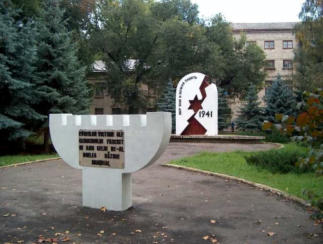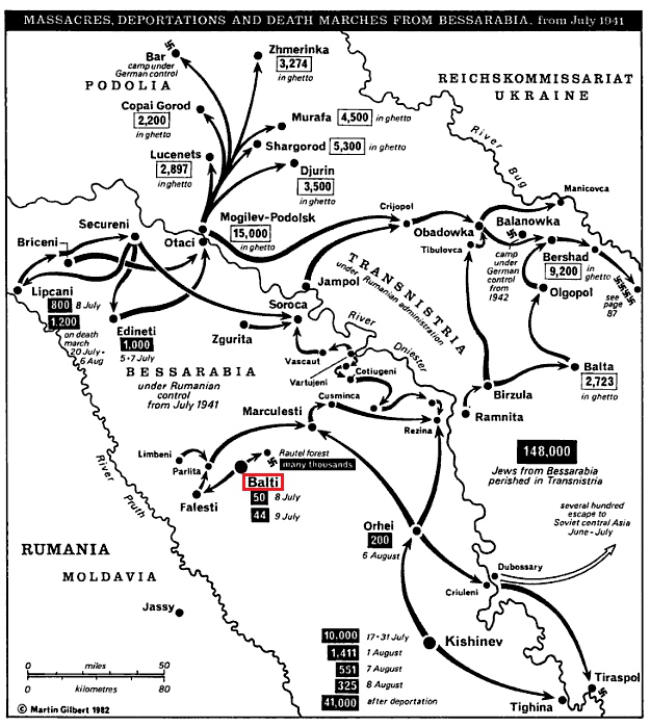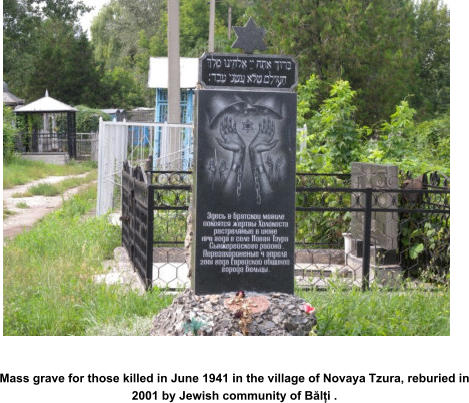

Copyright © 2017 Martin Davis



Footnotes:
1. Encyclopaedia Judaica (1971): Beltsy, vol. 4
2. Ancel Jean, “The Romanian way solving the Jewish Problem in Bessarabia and Bukovina, June-July 1941,” Yad Vashem Studies, 19,
Jerusalem 1988, p. 224.
3. Einsatzkommandos were a sub-group of five Einsatzgruppen mobile killing squads, whose mission was to kill Jews, Polish
intellectuals, Romani, communists and the NKVD collaborators in the captured territories often far behind the advancing German front
(see http://en.wikipedia.org/wiki/Einsatzkommando).
In June 1941, much of the town was destroyed by German and Romanian air raids. The Jews fled to the nearby villages, most to Vlad. On July 7, a
gang of Vlad peasants murdered occupants of homes sheltering the refugees and set fire to the houses. Some Romanian soldiers found fifty Jews on
the road to Bălți , drove them into the swamps, and shot them to death. Belz was captured by the Germans on July 9 and those Jews who had
returned were deported to a concentration camp.
The same day ten Jews who had been taken as hostages were executed. The Gestapo also asked the ghetto committee to furnish a list of 20 'Jewish
communists' who were to be put to death. When they refused to do so, all the committee members, together with another group of 44 Jews, were
forced to dig their own graves and shot. Twenty more Jews were shot by the Germans on July 16. On July 11, 1941 all the surviving Jews were
concentrated in the courtyard of the Bălți Moldova Bank.
The Romanian guards who took over from the Gestapo transferred all surviving Jews from there to an internment camp in the Rautel forest, some
seven and a half miles (12 km) from the town. Many of the inmates died from starvation and disease. By August 30, 1941, 8,941 Jews were left in the
entire district (as against the 31,916 residing there according to the 1930 census). They were concentrated in three camps, and later all were deported
to Transnistria, where most died.1

This footage has been placed on YouTube by Yad Vashem. It is taken from Nazi newsreel footage (Die Deutsche Wochenshau) of Bălți
and was filmed in July 1941. The film shows the aftermath of the heavy bombardment of the city and the exile of those Jews who
survived the bombing to a concentration camp.

Map 78 from The Routledge Atlas of the Holocaust by Martin Gilbert - courtesy of Martin Gilbert and the publishers
Monument in Bălţi in memory of the Holocaust victims was erected in the late 1990s on a specific site
where more than 1,000 Jews were killed.
The inscription reads:
"Peace unto you, for eternal remembrance
The Jewish victims of the Fascist genocide
During the years of the Second World War"

German Report, October 30, 1941
In a report sent by Reinhard Heydrich, Chief of the Nazi’s Security Police and SD to Hitler’s Reich Minister for
Foreign Affairs, Joachim von Ribbentrop, on October 30, 1941, appended to the first five reports of the
Einsatzgruppen3, he states:
The way in which the Romanians are dealing with Jews lacks any methods. No
objections could be raised against the numerous executions of Jews, but the technical
preparations and the executions themselves were totally inadequate. The Romanians
usually left the victims’ bodies where they were shot, without trying to bury them.
The Einsatzkommandos issued instructions to the Romanian police to proceed
somewhat more systematically in this matter.2















